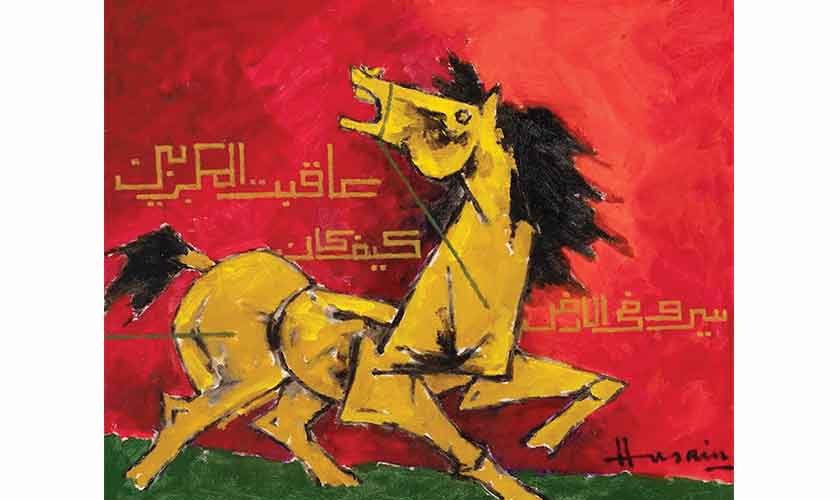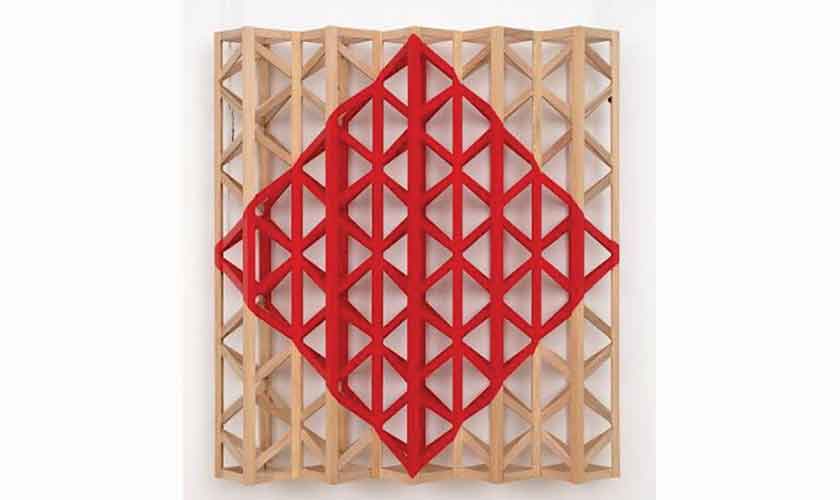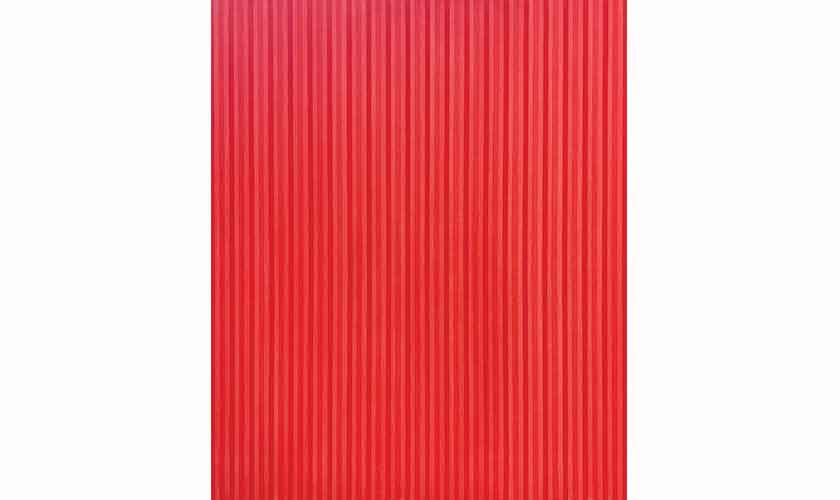The exhibition, Red, at the Art Dubai 2023, is an attempt to present how creative individuals respond to the colour red
rtists often finish their work by inscribing their names on them. Long before the language evolved into its present form, or script was invented, the makers of images left their signatures on their creations; impressions of their hands next to huge drawings of animals on the cave walls. One such site, Chauvet Cave in south-eastern France (discovered in December 1994), “contains more than 400 hand-stencils, hand-prints and palm-prints, and unlike the drawings of animals – most of which are in charcoal – every one of them is red.”
“Hands like these appear in dozens of prehistoric caves across France and Spain, as well as in India, South-East Asia, Africa, Australia and Patagonia.” These archaic signs of human presence/ touch were made “by mixing a red ochre pigment with blood or saliva.” From those distant centuries till the present times, the colour red has held a fascination for human beings. Despite our difference of skin-pigment, gender, age, body proportions, tongues, beliefs, nationalities, we share one colour in our heart, arteries, veins and vessels. It is a colour that stops us on the road, no matter if we are driving in Russia or Ukraine, in Palestine or Israel, in Iran or the US, in India or Pakistan. In the same way, it excites us regardless of our ethnic, political and economic differences.
Besides the possibility of love, red is also associated with violence, bloodshed and death; so whether circulating peacefully on the Valentine’s Day, or spilled abundantly at a carnage scene, it is difficult to deal with. The recent exhibition, Red, at Grosvenor Gallery, London, at the Art Dubai 2023, was also an attempt to present how creative individuals respond to this particular hue. The show, held from March 1 to 5, mainly featured artists from South Asia or those working here and exploring the traditional Indian aesthetics.
To describe red there are a number of options in English, like scarlet, vermillion, ruby, wine-colour, carmine. Similarly, one finds several terms in Urdu/ Hindi, but when it comes to visual material, red has innumerable shades, tints, tinges and tones. American artist Josef Albers explains this diversity in his book Interaction of Colour, “If one says Red (the name of a colour) and there are 50 people listening, it can be expected that there will be 50 reds in their minds. And one can be sure that all these reds will be very different.”
At the Grosvenor Gallery’s display, one did glimpse variations of red, not just within an optical framework, but in its cultural, social and psychological aspects as well – as indicated by the gallery’s invite with red written in four languages: Red (English), Ahmar (Arabic), Laal (Hindi), Surkh (Urdu).
The exhibition raises a question: does a colour remains the same after undergoing the metamorphosis of translation? Are Red and Ahmar identical; are Laal and Surkh similar?
The display provides some clues and indicates a few answers, merely through its choice of participating artists. Red was a denotation of danger, aggression, ambiguity, energy, spirituality or all of these, in the works preferred by Grosvenor Gallery for this year’s edition of Art Dubai. Interestingly, some paintings on view were created far back in time, or with other intentions and ideas, but the gallery’s curator has collected and interpreted these pieces with a different reading.
At the Grosvenor Gallery’s display one did glimpse variations of red, not only within an optical framework, but in its cultural, social and psychological aspects as well – as indicated by the gallery’s invite with red written in 4 languages: Red (English), Ahmar (Arabic), Laal (Hindi), Surkh (Urdu).
Though not much different, because MF Husain’s Untitled (Horse), the acrylic on canvas from 2000s, depicts a steed in yellow/ golden against a red background. The horse in a state of agitation refers to the stallion associated with Imam Hussain (with whom Allah was pleased). It is understood to have been pierced by many arrows. Somehow the action, movement and posture of the beast reminds one of the horse in Pablo Picasso’s Guernica. Both animals have witnessed war and death.
Modern day violence has also been delineated in red in some works. In Faiza Butt’s Gorgo I (2023), the face of a bearded man, blond so that he can be mistaken for a European/ English or an Afghan/ Pathan, is surrounded with keys of all sorts and cans. The most intriguing part of the work is that – since one cannot determine the identity of the main character – it is difficult to recognise him as a perpetrator or the victim of the blast that hovers in the upper part of the portrait. Faiza Butt has mastered the technique of rendering her subject in pointillistic manner, but in this particular ink-on-acetate-sheet, she has added a blob of red paint at the top of the head. Through its fluidity, liquidity and bleeding the mark indicates the expansion and continuation of atrocious designs in our midst.
Olivia Fraser, an artist of British origin residing and painting in India, has been investigating the South Asian art forms. She has created a sequence of pomegranate’s shapes on a grid (Gift, 2023) perhaps alluding to the variation and version of red in the context of a ripened fruit.
But if red is connected to the maturity of a vegetation, red could also be linked to the superiority of an idea, a form or its power. Zarah Hussain’s two acrylic-on-paper exhibits, Exhale III (2022) and Inhale III (2022), signify the strength of red that could emanate like power/ light, either at the centre of a circle or on its outer rim. In both instances, it is the colour red that becomes the breath of life. In Rasheed Araeen’s Bismillah2A (2021), more than the life, it turns into a semblance of the Creator. The name of God is inscribed in red, along with other forms in blue and yellow.
Every art student learns about three primary colours, somehow equal; but Araeen, disrupting this equilibrium, has painted a red square in grid form on a plain wooden structure (Diamond, 2022). This supremacy of red is sighted in a number of paintings by Muzzumil Ruheel, too. I it, the artist has forged spaces with a predominant red atmosphere. So there are traces of architectural structures or some texts, but by and large one suspects that the artist is more excited about the exhibition’s theme, Red, than for digging something original or personal.
On the other hand, two participants - Ghulam Mohammad and Mohmmad Ali Talpur - have switched their recognisable imagery, black and white into red. GM cuts and composes segments of Urdu script on a red background, so the text is imbedded into a red surface, in place of a greyish black or a pale white background: a cosmetic change. Mohammad Ali Talpur, usually prefers black and white (the conventional scheme of calligraphy) in his abstract, optical and geometric works, but has moved to a new hue.
He not only alternates his black and white grid into red, but also creates works with variations of red (number of coats) in his minimalist canvases. If an exhibition trains a viewer in decoding the red dot in SH Raza (Bindu Diptyque, 1992) as a cultural/ spiritual mark, it also makes a spectator to acknowledge that colour is not just a number/ code on a paint manufacturing factory’s shade card. It has a past, power and potential – aptly apparent at the Grosvenor Gallery’s booth at the recently concluded Art Dubai.
The writer is an art critic based in Lahore













